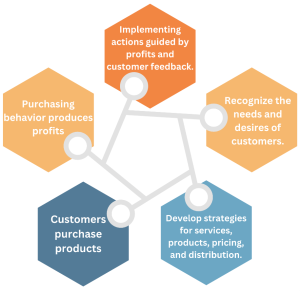6.1.2. The Marketing Cycle
Marketing is a process that involves specific and strategic activities tailored to meet customer needs and preferences.
Figure 6.1 illustrates the marketing cycle, which consists of the following steps:
- Identification of customers
- Development of products, pricing and distribution
- Customer purchases
- Generation of profits
- Taking appropriate action based on profits and customer feedback
Marketing works within a dynamic environment shaped by both external and internal influences. External factors encompass such elements as politics, the economy, government regulations, laws, social pressures, technology, local competition, industry trends and customer attitudes and behaviors. Internal factors include organizational goals, budgetary constraints and departmental policies.

Fig 6.1. The Marketing Cycle
The marketing cycle starts with identifying the potential customers who make up the target market. This market consists of a segment of the population that, as individuals or organizations, has a need for the products and possesses the ability, willingness and authority to purchase them. To identify the target market, the manager should consider the following questions:
- Who are our current customers and are we meeting their wants and needs?
- Who and where are our potential customers?
- What do we have, or what can we create, to attract new customers?
For example, the manager of a hospital foodservice program may find that potential customers include patients who have not been utilizing the meal service, as well as hospital staff, visitors and outpatient individuals who have not previously participated in the foodservice offerings. Numbers can be estimated by calculating the total number of inpatients, total staff and the estimated number of daily visitors to the hospital. Additional customers might include members of the local community who may participate in wellness programs or events hosted at the hospital. Finally, the unique needs of each group must be identified. These unique needs may include the desire for nutritious and easy-to-eat options for patients, quick and convenient meals for busy staff and diverse food choices for visitors. Specifically, the manager or marketing team needs to identify which aspects of food and service hold real or perceived value for potential and existing customers. Further judgment needs to be made on whether these customers will be willing to pay for these aspects or values.
Answering these questions can help the manager begin to define the market segments. Market segmentation divides the total market into smaller groups of people with similar product needs. Categories of customers emerge based on demographics, geographic location, psychographics and product preference. (Walker, 2004)
Media Attributions
- Picture1

